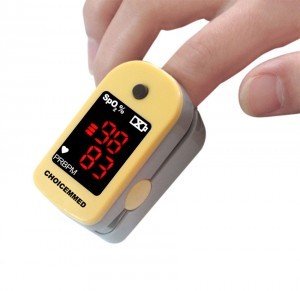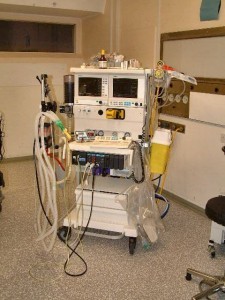Finger Pulse Oximeter
A finger or digit pulse oximeter is a non-invasive device for measuring the oxygen content of blood, also known as oxygen saturation. It is a highly portable device, which is indispensable for any emergency room or operation theater. Oxygen saturation is a measure of the body’s ability to pump oxygenated blood to all parts. Falling values of oxygen saturation may result from circulatory or respiratory failure and have to be instantly corrected. Inability to do so results in prompt loss of consciousness and even death due to insufficient supply of oxygen to brain. Hence, a finger pulse oximeter is a life-saving device !
Finger Pulse Oximeter Principle
A finger pulse oximeter consists of a clothes pin (or clothes peg) like arrangement of a plastic probe, which fits over the finger nail (Picture 1). One of the prongs contains two diodes, one emitting infra-red light and the other emitting red light. When this light passes through the finger tip there it is partially absorbed by the blood passing through the finger tip. The difference between the amount of red and infra-red light absorbed is related to the content of oxygen in the blood.
Picture 1: Finger Pulse Oximeter
(Source: Wikimedia Commons)
A microprocessor present in the device conducts these calculations and presents us with the value of the oxygen saturation, which is shown on the LED indicator. Normal values of oxygen saturation are 95-100%, but a drop till 90% is tolerable. A drop below 90% has to be aggressively managed with intubation and artificial ventilation with an Ambu bag to prevent brain damage and death.
Why is it called Finger Pulse Oximeter?
A finger pulse oximeter shows us the oxygen saturation value for every pulse (heart beat) of the patient. Hence, the name pulse oximeter, and since it is commonly used on the finger tip, it is called finger pulse oximeter. However, a finger pulse oximeter can also be used on other translucent parts of the body, like an ear lobe.
Finger Pulse Oximeter Uses
Picture 2: Anesthesia Machine
(Source: Wikimedia Commons)
- A pulse oximeter is an essential part of the anesthesia machine (Picture 2), which is regularly used by an anesthetist to monitor patients during any surgery.
- Ventilators used for monitoring critically ill or injured patients, like anaphylaxis, head injury, and so on, have an inbuilt pulse oximeter probe for monitoring oxygen saturation.
- Monitoring of respiratory failure due to COPD, asthma, etc., which frequently leads to labored breathing.
- Diagnosis and monitoring of sleep apnea or hypopnea.
- Used as a “vitality sensor” for entertainment purposes, like gaming, and so on. This is an upcoming non-medical use of this device and was announced by the company Nintendo.
Limitations of Finger Pulse Oximeter
- Finger pulse oximeter is a non-invasive device, hence, it is always less accurate than invasive blood tests, like arterial blood gas (ABG) monitoring.
- It does not help in distinguishing between failure of blood flow (circulatory failure) and failure of breathing (respiratory failure).
- Normal values do not completely rule out respiratory acidosis or inadequate blood flow.


